Connecting Bold BI to GitLab data source
The Bold BI dashboard designer supports connecting to GitLab web services through the REST API.
Choose GitLab data source
To configure the GitLab data source, follow the steps below:
-
Click on the Data Sources button in the configuration panel to add a new data connection.

-
Click on CREATE NEW to initiate a new connection from the connection panel.
-
Choose the GitLab connection from the connection panel.
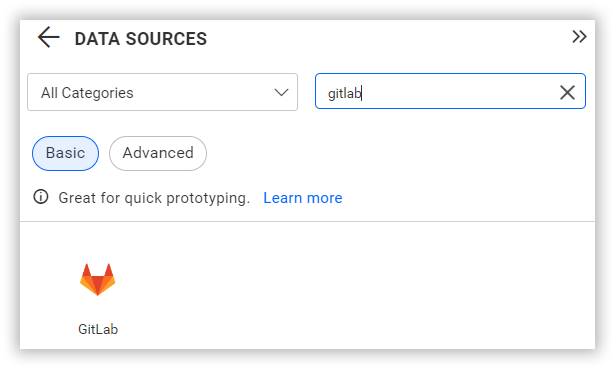
NOTE: You can also create a data source from the home page by clicking on the Data Sources menu in the left menu panel and selecting Create Data Source from the data sources page.
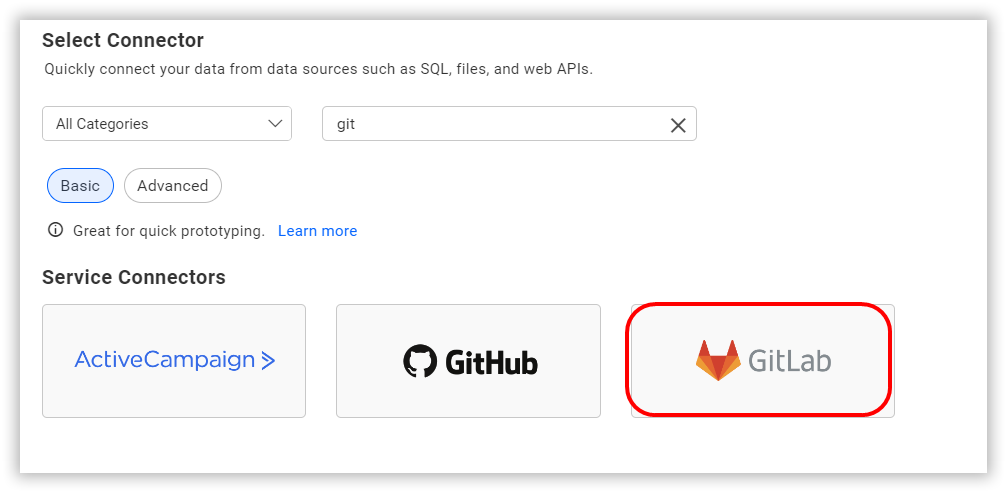
Create GitLab data source
Once you click the data source, the NEW DATA SOURCE configuration panel will open. Follow the steps below to create a GitLab data source:
-
Enter a name and description (optional) for the data source.
-
Enter a valid GitLab REST API endpoint in the URL textbox. Refer to the GitLab API documentation for more details.
Example:
https://<:your_gitlab_domain>.com/api/v4/merge_requests?state=opened&scope=assigned-to-me -
Select the GET method for the REST API in the Method combo box.
-
In Max Rows, enter the maximum number of rows to be fetched from the GitLab data source. This value is used to fetch the data from GitLab data source via pagination.
-
Replace <:your_access_token> under Headers and input a valid Access Token.
-
Choose a time interval for the Refresh Settings using the combo box, to periodically trigger the REST API request and keep the data in sync with our dashboard.
-
Select JSON data type in Data Format combo box.
-
Choose None under Authentication Type.
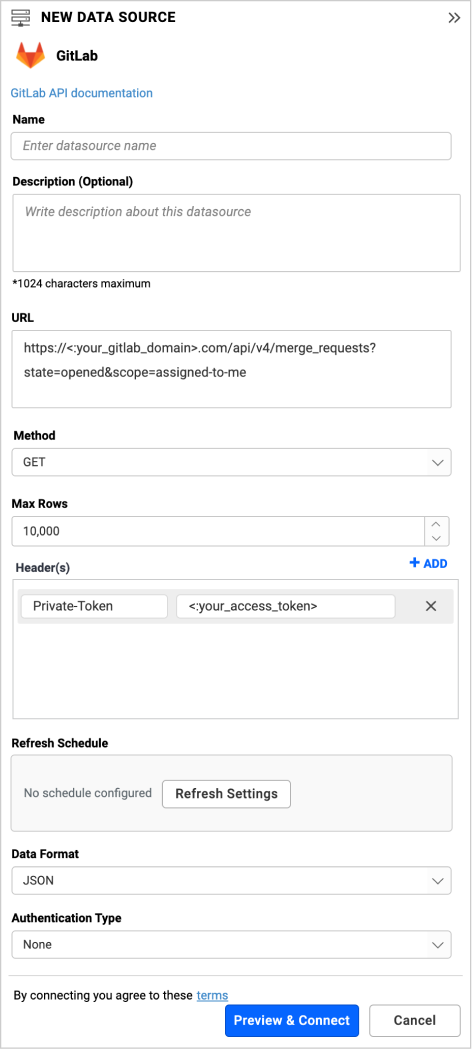
You can also edit the connection information set here by using the Edit Connection option.
How do I get Access Token for connecting GitLab data source?
-
Log in to your GitLab account. Click on your avatar and Go to User Profile -> Settings -> Access Tokens.
-
Choose a name for the token, set an optional expiry date, and select the desired scopes.
-
Click on
Create personal access tokenand make sure to save the access token. Note that once you leave or refresh the page, you will not be able to access it again. -
Use this Personal Access Token as the Access Token in the GitLab data source within the Bold BI Dashboard.
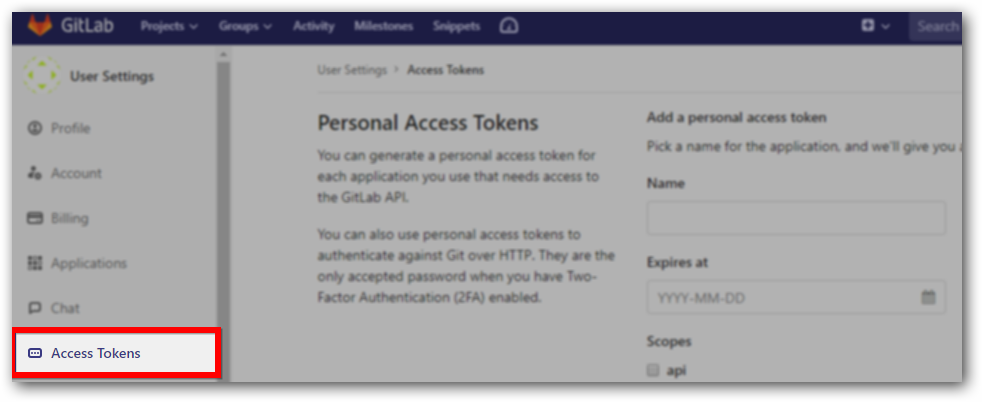
Additional information
| Max Rows | Most REST APIs return only a limited amount of data on a single API request. To retrieve the necessary amount of data, you can set a value in this field. Pagination is handled internally and will fetch the required data. |
| Refresh Settings | The period of time before the next refresh call is triggered. This will automatically trigger a call for the API configured in the data source to keep the data up to date. If you do not want to sync your new data, choose 'Never'. |
Setting up the URL
- For example, to retrieve the projects owned by a specific user, query the /users endpoint.
- Obtain the ID/username of the specific user from the provided information.
Replace it in the URL to query a particular user’s projects:
https://<:your_gitlab_domain>.com/api/v4/users/%3c:user_id%3e/projects
For more information on the API endpoints available for this data source, refer to their official API Documentation
Sample queries
List all Pipelines of specific Project
https://myorganization.com/api/v4/projects/12345/pipelines
List Merge Requests based on specific Labels
https://myorganization.com/api/v4/merge_requests?labels=bug,reproduced
Preview and data import
-
Click Preview & Connect to connect with the configurations that have been set.
-
The Choose Schema(s) dialog opens. The schema represents the key fields of JSON data retrieved from GitLab Rest API request. This dialog displays a list of schemas in a treeview and its corresponding values in grid for preview. Select required schema(s) from treeview to use in designer and click Connect.

-
Now, the data design view page with the selected table schema opens. Drag and drop the table.
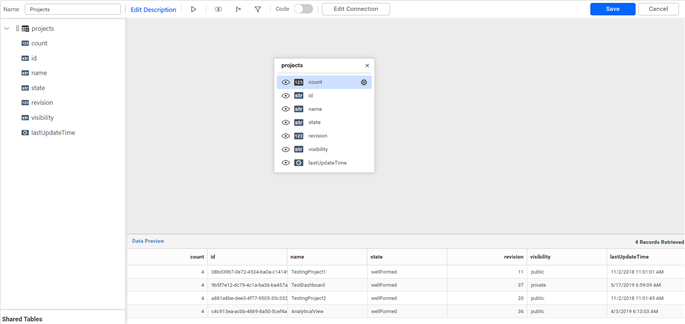
-
Click Save to save the data source with a relevant name.
Connect using custom attribute and dashboard parameter
We have added support for custom attributes and dashboard parameters in the data source connection. You can now connect to the data source using custom attributes or dashboard parameters.
Custom Attribute

Dashboard Parameter
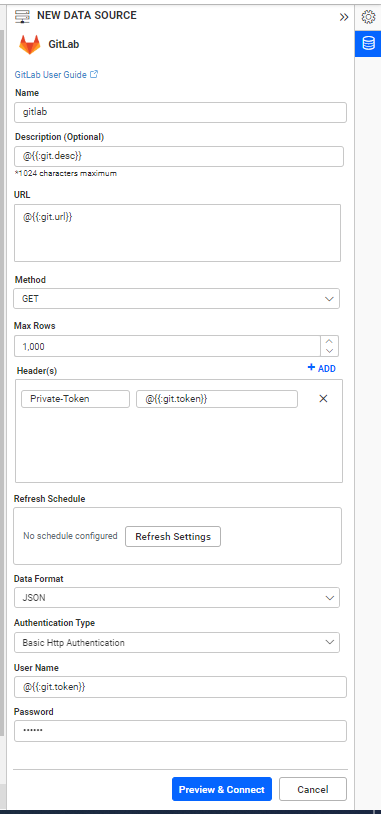
Note: Refer to the Dashboard Parameter Documentation and Custom Attributes Documentation for more details.
Related links
Having trouble getting help?
Contact SupportHaving trouble getting help?
Contact Support